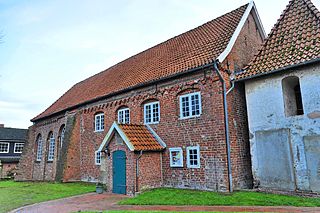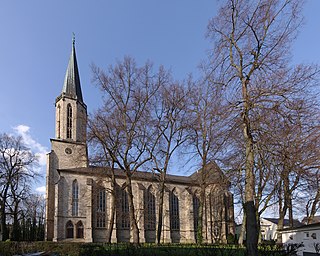
Lower Saxony is a German state (Land) situated in northwestern Germany. It is the second-largest state by land area, being larger than Denmark or the Netherlands with 47,624 km2 (18,388 sq mi), and fourth-largest in population among the 16 Länder federated as the Federal Republic of Germany. In rural areas, Northern Low Saxon and Saterland Frisian are still spoken, but the number of speakers is declining.
Gifhorn is a district in Lower Saxony, Germany.

The Prussian Union of Churches was a major Protestant church body which emerged in 1817 from a series of decrees by Frederick William III of Prussia that united both Lutheran and Reformed denominations in Prussia. Although not the first of its kind, the Prussian Union was the first to occur in a major German state.

Wittingen is a town in the district of Gifhorn, Lower Saxony, Germany. It is about 30 kilometres (19 mi) northeast of Gifhorn, and 30 kilometres (19 mi) southeast of Uelzen.

Brome is a municipality in the district of Gifhorn, in Lower Saxony, Germany. It is situated on the river Ohre, approx. 25 km northeast of Wolfsburg.

The Sophienkirche is a Protestant church in the Spandauer Vorstadt part of the Berlin-Mitte region of Berlin, eastern Germany. One of its associated cemeteries is the Friedhof II der Sophiengemeinde Berlin.
The Osthannoversche Eisenbahnen AG (OHE) is a Celle based transportation company with railway network in North-eastern Lower Saxony around the Lüneburg Heath area of over 250 km.

The Großes Moor near Gifhorn is part of the Northwest German raised bog region, which stretches from the Netherlands to the eastern border of Lower Saxony on the sandy areas (geest) left behind by the ice age. The moor has a total area of about 6,100 hectares, of which around 5,000 hectares are raised bog and some 1,100 hectares are fen. The peat layer is up to almost 6 metres thick in places. Individual parts of the moor have their own names like Stüder Moor, Hestenmoor or Weißes Moor.

Drömling is a sparsely populated depression on the border of Lower Saxony and Saxony-Anhalt in Germany with an area of about 340 square kilometres (130 sq mi). The larger part belonging to Saxony-Anhalt in the east has been a nature park since 1990. The former swampland was transformed by drainage from a natural into a cultural landscape in the 18th century under the direction of Frederick the Great of Prussia. Today the depression, with its waterways, the Mittelland Canal and the rivers Aller and Ohre is a refuge for rare or endangered species of animal and plant. Most of the area is now made up of nature reserves and protected areas. Nearby towns include Oebisfelde and Wolfsburg.

The Ise is a 43 km (27 mi) long, almost natural river of East Lower Saxony and Saxony-Anhalt, Germany. It crosses the district of Gifhorn from north to south and discharges into the Aller at Gifhorn itself.
The Celle–Wittingen Light Railway was founded on 21 June 1902 by the Prussian state, the town of Celle and 33 municipalities. On 15 August 1904 it opened the 51 km long, standard gauge line from Celle Stadt (Nord) via Beedenbostel and Hankensbüttel to Wittingen West. This line was also called the Lachte Valley Railway (Lachtetalbahn) because part of it ran along the river Lachte. The journey time on the Celle–Wittingen line in 1906 was about 2 hours and 20 minutes. In 1908 the station at Wittingen West was moved to the east side of the state station in order to enable a common station to be created with the Kleinbahn Wittingen-Oebisfelde, opened in 1909, and the Kleinbahn Bismark-Gardelegen-Wittingen, later the Altmärkische Kleinbahn AG. The new route made the construction of embankments and a bridge over the state railway necessary.
The Wittingen-Oebisfelde Light Railway was a railway company in Germany that operated passenger and goods trains on the 43 kilometre long Wittingen–Oebisfelde railway.

Radenbeck is a village in the town of Wittingen in the district of Gifhorn in the north German state of Lower Saxony.

The village of Kakerbeck lies in the north German state of Lower Saxony in the district of Gifhorn. It is a village in the town of Wittingen.

Hans Joachim Schliep is a German Lutheran theologian, pastor and author. From 1990 to 1999 he was director of the Amt für Gemeindedienst, and by May 2000 the commissioner for the environment of the Church of Hanover and the Confederation of Protestant Churches in Lower Saxony. From 1999 to 2008 Schliep was the first pastor at the Kronsberg Church Centre and founder of the congregation at the Expo-neighbourhood in Kronsberg, Hanover, Lower Saxony, Germany.
The so-called Kwami-Affair has been caused by Carl Röver, Nazi-Gauleiter of Weser-Ems, and the Free State of Oldenburg, when he attempted to prevent a sermon held by the Ghanaian Pastor Robert Kwami September 20, 1932, in the St. Lamberti Church in the city of Oldenburg.
Horst Wolfgang Böhme is a German archaeologist with a focus on Late Antiquity / Early Middle Ages and research into castles.

The Holy Cross Church is the church of the Neuenwalde Convent. Convent and Holy Cross Church are owned by the Bremian Knighthood, based in Stade. However, church and parsonage, are used per usufruct by the Lutheran Neuenwalde Congregation in Neuenwalde, a locality of Geestland, Lower Saxony, Germany. Besides the Holy Cross Church, only used, the congregation uses and owns the chapel in Hymendorf.

St. Nicolai is a church and Lutheran parish in Lüneburg, Lower Saxony, Germany. It is one of three main churches in the town, all built in brick Gothic style. The church, dedicated to St. Nicholas, is a basilica with three naves, built from 1407 to 1440. It features a "star" rib vault that is unique in Northern Germany. When the Reformation was introduced in Lüneburg in 1530, the church became Lutheran. The high steeple was added in the 19th century.

The Große Kirche Aplerbeck is a Protestant church in Aplerbeck, now part of Dortmund, Germany. It was built from 1867 to 1869 in Gothic Revival style, designed by Christian Heyden. A listed monument, it is used by the parish St. Georg, serving mostly as a concert church.
















